现代大学英语中级写作(上)_Unit 2 PPT
- 格式:ppt
- 大小:1.96 MB
- 文档页数:17
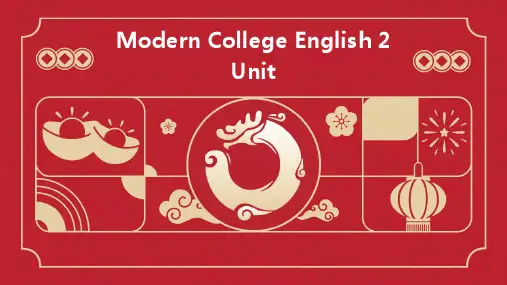

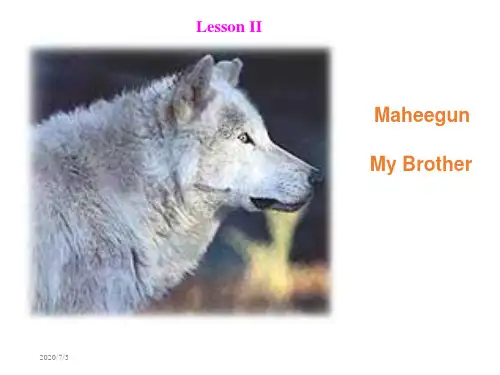

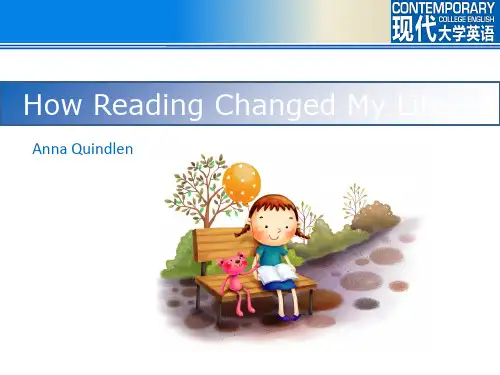


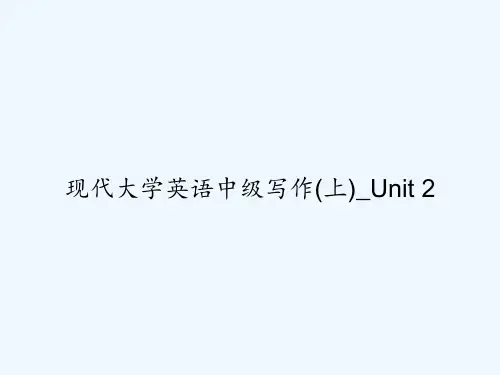
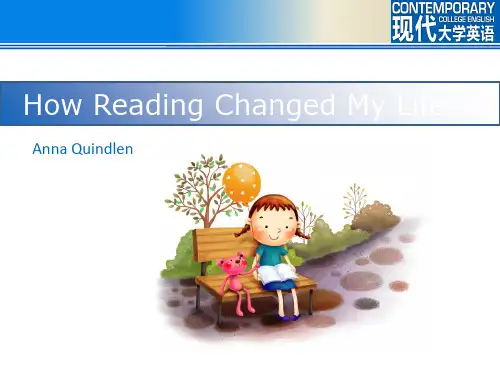

《现代大学英语中级写作》,徐克容,外语教学与研究出版社英语写作中级(上)课程教案I 授课题目:Unit One We Learn As We Grow一、教学目的、要求:(一)掌握:1、To learn the basics of exemplication:→ Definition→ Kinds of examples→ Sources of examples2、To learn to outline expositive essays知识点:→ The definition and introduction of exposition and essay.→Exposition is explanatory writing. It’s purpose is to explain or clarify a point.→ An essay is a related group of paragraphs written for some purpose(二)熟悉:→ Practice the basics of exemplification→ Practice outlining知识点:→Patterns of exposition, the choice of examples, the choice of appropriate examples, the organization of an exemplification essay:→Types of essays, basic structures of an expositive essay, elements of the expositive essay→ Types of outline, rules concerning outline(三)了解:→Patterns of exposition, types of essays, types of outlineprocess analysis, cause-effect analysis, Comparison and contrast, classification,definition and analogy,narrative essays, descriptive essays, expositive essaysand argumentative essays二、教学重点及难点:重点:Exemplification,types of outline;难点:Sentence outline and topic outline三、课时安排:共4课时四、授课方式:讲授、课堂快速阅读练习、课堂提问、写作实践讲解五、教学基本内容第一課Exemplification第一課Elements of the Essay: Outlining六、参考书目:《英语写作手册》,《美国大学英语写作》七、作业和思考题:第一次:Read on the subject and write an example paper of 200-250 words on the given topic. 第二次:Read on the subject and write an essay of 200-250 words on the given topic, using eithera single extended example or two or three short ones to develop your thesis statement. 第三次:Ask students to practice outlining八、课后小结:Emphasis on the writing procedure→Prewriting-choosing a topic and exploring ideas→Drafting: getting your ideas on paper→Revising: strengthening your essay→Editing and proofreading: eliminating technical errorsII授课题目:Unit Two I Made It一、教学目的、要求:(一)掌握:1、To learn the basics of process analysis→ Definition→ Uses→ Types→ Methods2、To learn to write thesis statement知识点:→ The definiton and introduction of process analysis→ The function of process analysis→ The differences between thesis statement vs. topic sentence(二)熟悉:→ The areas the process analysis is usually used.知识点: → Functions of process analysis:giving instructions, giving information and giving the history→Major types of process analysis: directive analysis, informative process analysis→Writing an effective thesis statement(三)了解:The basics of process writing and thesis statement二、教学重点及难点:重点:Organization of a process paper, practice of effective thesis statement;难点:Guidelines on process analysis, writing effective thesis ststement三、课时安排:共4课时四、授课方式:讲授、课堂快速阅读练习、课堂提问、写作实践讲解五、教学基本内容第二課Process Analysis第二課Elements of the essay: The Thesis Statement六、参考书目:《英语写作手册》,《美国大学英语写作》七、作业和思考题:第一次:Read on the subject and write an informative process paper describing how you succeeded in doing something第二次:Read on the subject and write a directive process paper telling first-year students how to adjust to life at college.第三次:Ask students to practise writing the thesis statement八、课后小结:Emphasis on the writing procedure→ Prewriting-chossing a topic and exploring ideas→Drafting:getting your ideas on paper→Revising: strengthening your essay→Editing and proofreading: eliminating technical errors授课题目:Unit Three College Is Not a Paradise一、教学目的、要求:(一)掌握:1、To learn the basics of Cause-Effect analysis→ Definition→ Uses→ Patterns2、To learn to write an introduction to expositive essays→ What to include in the introduction→ How to write effective introduction知识点:→ The definiton and introduction of cause-effect analysis→ The function of cause-effect analysis→ The writing of effective introduction(二)熟悉:→ The functions and areas the cause-effect analysis is usually used.知识点: → Functions of cause-effect analysis: explaining why certain things happen, analyzing what will happen as a result→Major types of cause-effect analysis: focusing on cause and focusing on effects,→How to start and write effective introduction(三)了解:the basics of cause-effect analysis and writing effective introduction二、教学重点及难点:重点:How to focus on cause or effects, How to start and write effective introduction;难点:How to focus on cause or effects, How to start and write effective introduction三、课时安排:共4课时四、授课方式:讲授、课堂快速阅读练习、课堂提问、写作实践讲解五、教学基本内容第三課Cause-Effect Analysis第三課Parts of the essay: The Introduction六、参考书目:《英语写作手册》,《美国大学英语写作》七、作业和思考题:第一次:Read on the subject and write an essay on any of the given topics analyzing cause.第二次:Read on the subject and write, from your own experience, an essay analyzing the effects of anthing taught in class.第三次:Ask students to practise writing the introduction八、课后小结:Emphasis on the writing procedure→ Prewriting- chossing a topic and exploring ideas→Drafting: getting your ideas on paper→Revising: strengthening your essay→Editing and proofreading: eliminating technical errors授课题目:Four What Makes the Differences一、教学目的、要求:(一)掌握:1、To learn the basics of Comparison and Contrast→ Definition→ Uses→ Patterns→ Methods2、To learn to develop the body of expositive essays→ What its structure looks like?→ What it includes知识点:→ The definiton and introduction of Comparison and Contrast→ The function of cause-effect analysis→ The writing of effective introduction(二)熟悉:→ The functions and areas the comparison/contrast is usually used., the general structure of the body of an essay知识点: →Functions of comparison/contrast: clarifying something unknown, bringing one or both of the subject into sharper shape→Three patterns of comparison/contrast: subject by subject, point by point, mixed sequence→Familiarity of the general structure of the body of an essay(三)了解:The basics of Comparison and Contrast and the general structure of the body of an essay二、教学重点及难点:重点:Three patterns of comparison/contrast: subject by subject, point by point, mixed sequence General structure of the body: Beginning, Body and End难点:How to organize a comparison/contrast essay, How to develop body paragraphs三、课时安排:共4课时四、授课方式:讲授、课堂快速阅读练习、课堂提问、写作实践讲解五、教学基本内容第四課Comparison/Contrast第四課Parts of the essay: The Body六、参考书目:《英语写作手册》,《美国大学英语写作》七、作业和思考题:第一次:Read on the subject and write a subject-by-subject essay of comparison/contraston any of the given topics第二次:Read on the subject and write a point -by-point essay of comparison/contraston any of the given topics第三次:Ask students to practise writing the body of the essay八、课后小结:Emphasis on the writing procedure→ Prewriting-chossing a topic and exploring ideas→Drafting:getting your ideas on paper→Revising: strengthening your essay→Editing and proofreading: eliminating technical errors授课题目:Unit Five It Takes All Sorts to Make a World一、教学目的、要求:(一)掌握:1、To learn the basics of Classification→ Definition→ Uses→ Methods2、To learn to write the conclusion of expositive essays→ What is classification?→ What is classification used for?知识点:→ The definiton and introduction of classification→ The function of classification→ The writing of effective classification(二)熟悉:→ The functions and areas the classification is usually used., the conclusion of expositive essays知识点: → Functions of classification:To organize and perceive the world around usTo present a mass of material by means of some orderly systemTo deal with complex or abstract topics by breaking a broad subject into smaller,neatly sorted categories.→The general pattern of classification→sentence patterns in classification→Familiarity of the the conclusion of expositive essays(三)了解:The functions and areas the classification is usually used., the conclusion of expositive essays二、教学重点及难点:重点:some sentence patterns in classificationthe conclusion of expositive essays难点:Parts of the conclusion: a summary of the main points, or restatements of your thesis in different work.三、课时安排:共4课时四、授课方式:讲授、课堂快速阅读练习、课堂提问、写作实践讲解五、教学基本内容第五課classification第五課Parts of the essay: The conclusion六、参考书目:《英语写作手册》,《美国大学英语写作》七、作业和思考题:第一次:Read on the subject and write a classification essay on any of the given topics第二次:Write an essay of 200-250 words on any of the given topics.第三次:Ask students to practise writing the conclusion of the essay八、课后小结:Emphasis on the writing procedure→ Prewriting-chossing a topic and exploring ideas→Drafting:getting your ideas on paper→Revising: strengthening your essay→Editing and proofreading: eliminating technical errors授课题目:Unit Six What Does It Mean一、教学目的、要求:(一)掌握:1、To learn the basics of Definition→ Definition→ Types→ Methods of Organization2、To learn to write the title of expositive essays→ What is definiton→ Types of definition知识点:→ The Standard /Formal Definition→ The Connotative/Personal Definition→ The Extended Definition(二)熟悉:→ The functions and areas the definition is usually used., the title of expositive essays知识点: →Functions and patterns of definition:→ The Standard /Formal Definition is used to explain a term or concept your audience or reader may not know or understand,→The Connotative/Personal Definition is used to explain any word or concept that doesn’t have the same meaning for everyone.→The Extended Definition is used to explore a topic by examining its various meanings and implications.(三)了解:How to write an extended definitionHow to organize an extended essay二、教学重点及难点:重点:Functions and patterns of definitionHow to write an extended definitionHow to write the title of an expositive essay难点:How to organize an extended essayHow to write the title of an expositive essay三、课时安排:共4课时四、授课方式:讲授、课堂快速阅读练习、课堂提问、写作实践讲解五、教学基本内容第六課definition第六課Parts of the essay: The Title六、参考书目:《英语写作手册》,《美国大学英语写作》七、作业和思考题:第一次:Read on the subject and write a definition essay on any of the given topics 第二次:Write an essay of 200-250 words on any of the given topics.第三次:Ask students to practise writing the title of the essay八、课后小结:Emphasis on the writing procedure→ Prewriting- choosing a topic and exploring ideas→Drafting: getting your ideas on paper→Revising: strengthening your essay→Editing and proofreading: eliminating technical errorsUnit Six Task One DefinitionI What is definition?In talking with other people, we sometimes offer informal definitions to explain just what we mean by a particular term. That is, to avoid confusion or misunderstanding, we have to define aword, term, or concept which is unfamiliar to most readers or open to various interpretations.Suppose, for example, we say to a friend:”Forrest is really an inconsiderate person.”We might then explain what we mean by “ inconsiderate” by saying, “He borrowed my accounting book overnight but didn’t return it for a week. And when I got it back, it was covered with coffee stains.Definition is the explanation of the meaning of a word or concept, and it is also a method of developing an essay.II. The ways to define a word or termThere are three basic ways to define a word or termA. To give a synonym For example: ‘ To mend is to repair.”Or “ A fellow is a man or aboy.”B. To use a sentence (often with an attributive clause) For example, ink may be define in asentence: “Ink is colored water which we use for writing.”C. To write a paragraph or even an essay But a synonymy or a sentence cannot give asatisfactory definition of an abstract term whose meaning is complex. We have to write a paragraph or an essay with examples or negative examples (what the term does not mean), with analogies or comparisons, with classification or cause-effect analysis.III. When we give a definition, we should observe certain principles:1.First, we should avoid circular definitions. “Democracy is the democratic process.”And“astronomer is one who studies astronomy” are circular definition.2.Second, we should avoid long lists of synonyms if the term to be defined is an abstract one.For example: By imagination, I mean the power to form mental images of objects, the power to form new ideas, the gift of employing images in writing, and the tendency to attribute reality to unreal things, situations and states.(picking up words, expressions from a dictionary , in the hope that one will hit)3.Third, we should avoid loaded definition, Loaded definitions do not explain terms but makean immediate appeal for emotional approval.A definition like:’ By state enterprise, I mean high cost and poor efficiency.” is loaded withpejorative emotional connotation. Conversely, “ By state enterprise, I mean one of the great blessing of democratic planning”is loaded with favorable emotional connotation. Such judgements can be vigorious to a discussion, but they lead to argument, not clarification, when offered as definition.IV. Types of definition1.Standard/ Formal definition---denotation is a word’s core, direct, and literal meaning.2.Connotative/Personal meaning---Explains what you mean by a certain term or concept thatcould have different meanings for others.On the other hand, connotation is the implied, suggested meaning of a word; it refers to the emotional response stimulated by associations the word carries with it.A.For Americans, Water gate is associated with a political scandal that means dishonesty.And more words are created with the suffix—gate to mean some scandal in English now, thus, Iran Gate, Intelligence GateB.Dogs, in Chinese culture, may be quite a negative image. It is insulting to call someone adog. What about the western people? In their eyes, dog is lovely and has good associated meanings. They say “ Love me, love my dog.”C.Imperialism means to us Chinese quite negative. Some of the western people may beproud of being imperial and imperialism itself.D.People everywhere may also share some connotations for some words. They are generalconnotations. Mother means love, care, selfless, etc.E.Let’s get the gang together for a party tonight. (a group)Don’t go around with that gang or you’ll come to no good. (degraded group of people or group of criminals)Connotation can make all the difference. It is the mirror of your attitude.3.Extended definition---is an essay length piece of writing using this method of development. V. How to write an extended definitionFollow 4 rules for a good definition:1. Don’t use the words “when “‘where”, giving a definition. A common practice is to definethe noun with a noun, adjective with adjective and so on.2. Remember, that definition is not a repetition.3. Use simple and well- known term in your explanation.4. Point out the distinguishing features of the term.Unit Six Task Two: The TitleI.What is title?A title is a very brief summary of what your paper is about. It is often no more thanseveral words. You may find it easier to write the title after you have completed your paper.A title may be a phrase which can indicate a topic of interest (i.e. your focus) and at thesame time point towards a particular kind of discussion (your mode of argument).Accordingly, your title needs not only to indicate what the essay will be about, but also to indicate the point of view it will adopt concerning whatever it is about.II.The purpose of the titleTo give the reader an idea of what the essay is aboutTo provide focus for the essayTo arouse the reader’s interestIII.How to write a good titleMake it clear, concise and preciseUse a phrase rather than a sentenceExclude all extra wordsIV.Other rules to obeyCenter it at the top of the first page.Use no period at the end or quotation marksCapitalize the first and last wordsCapitalize all other words except●articles (a, the)●the to in infinitives●prepositions containing one syllable●coordinating conjunctions (and, but, or, etc)A title leads, but a poor title misleads. Be sure that it is appropriate. Besides, be careful with the capitalization.Write an appropriate title for each of the introductory paragraphs that follow.1.Title: _____Reactions to Disappointment___________________Ben Franklin said that the only sure things in life are death and taxes. He left something out, however: disappointment. No one gets through life without experiencing many disappointments. Strangely, though, most people seem unprepared for disappointment and react to it in negative ways. They feel depressed or try to escape their troubles instead of using disappointments asan opportunity for growth.2.Title: ____Annoying People_____________________President Richard Nixon used to keep “enemies list” of all the people he didn’t especially like. Iam ashamed to confess it, butI, too, have an enemies list—a mental one. On this list are the people I would gladly live without , the ones who cause my blood pressure to rise to the boiling point. The top three places on the list go to people with annoying nervous habits, people who talk in movie theatres, and people who talk on car phones while driving.3.Title: ___The Meaning of Maturity______________________Being a mature student does not mean being an old-timer. Maturity is not measured by the number of years a person have lived. Instead, the yardstick of maturity is marked by the qualities of self-denial, determination, and dependability.4.Title: _____College Stress____________________Jack’s heart pounds as he casts panicky looks around the classroom. He doesn’t recognize the professor, he doesn’t know any of the students, and he can’t even figure out what the subject is. In front of him is a test. At the last minute his roommate awakens him. I t’s only another anxiety dream. The very fact that dreams like Jack’s are common suggests that college is a stressful situation for young people. The cause of this stress can be academic, financial, and personal.5.Title: __How to Complain_______________________I’m not just a consumer—I’m a victim. If I order a product, it is sure to arrive in the wrong color, sixe, or quantity. If I hire people to do repairs, they never arrive on the day scheduled.If I owe a bill, the computer is bound to overcharge me. Therefore, in self-defense, I have developed the following consumer’s guide to complaining affectively授课题目:Unit Seven The Insight I Gained一、教学目的、要求:(一)掌握:1、To learn the basics of Analogy→ Definition→ Uses→ Methods of Organization2、To learn to use transitions→ What is analogy→ The difference between analogy and comparison知识点:→ The field analogy is used→ The difference between analogy and comparison→ The patterns of analogy(二)熟悉:→The functions and areas analogy is usually used., to learn to use transition知识点: →Functions and patterns of analogy:→ A comparison explains two obviously similar things and considers both their differences and similarities→ An analogy compares two apparently unlike things, and focus only on their major similarities→An analogy is thus an extended metaphor—the figure of speech that declares one thing to be another(三)了解:How to organize an analogy by the way ---subject by subjectHow to organize an analogy by the way—point by point二、教学重点及难点:重点:Functions and patterns of definitionThe differences between comparison and analogyHow to learn to use transitionHow to organize an analogy by the way ---subject by subjectHow to organize an analogy by the way—point by point难点:How to learn to use transitionHow to organize an analogy by the way ---subject by subjectHow to organize an analogy by the way—point by point三、课时安排:共4课时四、授课方式:讲授、课堂快速阅读练习、课堂提问、写作实践讲解五、教学基本内容第六課definition第六課Parts of the essay: The Title六、参考书目:《英语写作手册》,《美国大学英语写作》七、作业和思考题:第一次:Read on the subject and write a definition essay on any of the given topics 第二次:Write an essay of 200-250 words on any of the given topics.第三次:Ask students to practise writing the title of the essay八、课后小结:Emphasis on the writing procedure→ Prewriting-chossing a topic and exploring ideas→Drafting: getting your ideas on paper→Revising: strengthening your essay→Editing and proofreading: eliminating technical errors。

《现代大学英语中级写作》,徐克容,外语教学与研究出版社英语写作中级(上)课程教案I 授课题目:Unit One We Learn As We Grow一、教学目的、要求:(一)掌握:1、To learn the basics of exemplication:→ Definition→ Kinds of examples→ Sources of examples2、To learn to outline expositive essays知识点:→ The definition and introduction of exposition and essay.→Exposition is explanatory writing. It’s purpose is to explain or clarify a point.→ An essay is a related group of paragraphs written for some purpose(二)熟悉:→ Practice the basics of exemplification→ Practice outlining知识点:→Patterns of exposition, the choice of examples, the choice of appropriate examples, the organization of an exemplification essay:→Types of essays, basic structures of an expositive essay, elements of the expositive essay→ Types of outline, rules concerning outline(三)了解:→Patterns of exposition, types of essays, types of outlineprocess analysis, cause-effect analysis, Comparison and contrast, classification,definition and analogy,narrative essays, descriptive essays, expositive essaysand argumentative essays二、教学重点及难点:重点:Exemplification,types of outline;难点:Sentence outline and topic outline三、课时安排:共4课时四、授课方式:讲授、课堂快速阅读练习、课堂提问、写作实践讲解五、教学基本内容第一課Exemplification第一課Elements of the Essay: Outlining六、参考书目:《英语写作手册》,《美国大学英语写作》七、作业和思考题:第一次:Read on the subject and write an example paper of 200-250 words on the given topic. 第二次:Read on the subject and write an essay of 200-250 words on the given topic, using eithera single extended example or two or three short ones to develop your thesis statement. 第三次:Ask students to practice outlining八、课后小结:Emphasis on the writing procedure→Prewriting-choosing a topic and exploring ideas→Drafting: getting your ideas on paper→Revising: strengthening your essay→Editing and proofreading: eliminating technical errorsII授课题目:Unit Two I Made It一、教学目的、要求:(一)掌握:1、To learn the basics of process analysis→ Definition→ Uses→ Types→ Methods2、To learn to write thesis statement知识点:→ The definiton and introduction of process analysis→ The function of process analysis→ The differences between thesis statement vs. topic sentence(二)熟悉:→ The areas the process analysis is usually used.知识点: → Functions of process analysis:giving instructions, giving information and giving the history→Major types of process analysis: directive analysis, informative process analysis→Writing an effective thesis statement(三)了解:The basics of process writing and thesis statement二、教学重点及难点:重点:Organization of a process paper, practice of effective thesis statement;难点:Guidelines on process analysis, writing effective thesis ststement三、课时安排:共4课时四、授课方式:讲授、课堂快速阅读练习、课堂提问、写作实践讲解五、教学基本内容第二課Process Analysis第二課Elements of the essay: The Thesis Statement六、参考书目:《英语写作手册》,《美国大学英语写作》七、作业和思考题:第一次:Read on the subject and write an informative process paper describing how you succeeded in doing something第二次:Read on the subject and write a directive process paper telling first-year students how to adjust to life at college.第三次:Ask students to practise writing the thesis statement八、课后小结:Emphasis on the writing procedure→ Prewriting-chossing a topic and exploring ideas→Drafting:getting your ideas on paper→Revising: strengthening your essay→Editing and proofreading: eliminating technical errors授课题目:Unit Three College Is Not a Paradise一、教学目的、要求:(一)掌握:1、To learn the basics of Cause-Effect analysis→ Definition→ Uses→ Patterns2、To learn to write an introduction to expositive essays→ What to include in the introduction→ How to write effective introduction知识点:→ The definiton and introduction of cause-effect analysis→ The function of cause-effect analysis→ The writing of effective introduction(二)熟悉:→ The functions and areas the cause-effect analysis is usually used.知识点: → Functions of cause-effect analysis: explaining why certain things happen, analyzing what will happen as a result→Major types of cause-effect analysis: focusing on cause and focusing on effects,→How to start and write effective introduction(三)了解:the basics of cause-effect analysis and writing effective introduction二、教学重点及难点:重点:How to focus on cause or effects, How to start and write effective introduction;难点:How to focus on cause or effects, How to start and write effective introduction三、课时安排:共4课时四、授课方式:讲授、课堂快速阅读练习、课堂提问、写作实践讲解五、教学基本内容第三課Cause-Effect Analysis第三課Parts of the essay: The Introduction六、参考书目:《英语写作手册》,《美国大学英语写作》七、作业和思考题:第一次:Read on the subject and write an essay on any of the given topics analyzing cause.第二次:Read on the subject and write, from your own experience, an essay analyzing the effects of anthing taught in class.第三次:Ask students to practise writing the introduction八、课后小结:Emphasis on the writing procedure→ Prewriting- chossing a topic and exploring ideas→Drafting: getting your ideas on paper→Revising: strengthening your essay→Editing and proofreading: eliminating technical errors授课题目:Four What Makes the Differences一、教学目的、要求:(一)掌握:1、To learn the basics of Comparison and Contrast→ Definition→ Uses→ Patterns→ Methods2、To learn to develop the body of expositive essays→ What its structure looks like?→ What it includes知识点:→ The definiton and introduction of Comparison and Contrast→ The function of cause-effect analysis→ The writing of effective introduction(二)熟悉:→ The functions and areas the comparison/contrast is usually used., the general structure of the body of an essay知识点: →Functions of comparison/contrast: clarifying something unknown, bringing one or both of the subject into sharper shape→Three patterns of comparison/contrast: subject by subject, point by point, mixed sequence→Familiarity of the general structure of the body of an essay(三)了解:The basics of Comparison and Contrast and the general structure of the body of an essay二、教学重点及难点:重点:Three patterns of comparison/contrast: subject by subject, point by point, mixed sequence General structure of the body: Beginning, Body and End难点:How to organize a comparison/contrast essay, How to develop body paragraphs三、课时安排:共4课时四、授课方式:讲授、课堂快速阅读练习、课堂提问、写作实践讲解五、教学基本内容第四課Comparison/Contrast第四課Parts of the essay: The Body六、参考书目:《英语写作手册》,《美国大学英语写作》七、作业和思考题:第一次:Read on the subject and write a subject-by-subject essay of comparison/contraston any of the given topics第二次:Read on the subject and write a point -by-point essay of comparison/contraston any of the given topics第三次:Ask students to practise writing the body of the essay八、课后小结:Emphasis on the writing procedure→ Prewriting-chossing a topic and exploring ideas→Drafting:getting your ideas on paper→Revising: strengthening your essay→Editing and proofreading: eliminating technical errors授课题目:Unit Five It Takes All Sorts to Make a World一、教学目的、要求:(一)掌握:1、To learn the basics of Classification→ Definition→ Uses→ Methods2、To learn to write the conclusion of expositive essays→ What is classification?→ What is classification used for?知识点:→ The definiton and introduction of classification→ The function of classification→ The writing of effective classification(二)熟悉:→ The functions and areas the classification is usually used., the conclusion of expositive essays知识点: → Functions of classification:To organize and perceive the world around usTo present a mass of material by means of some orderly systemTo deal with complex or abstract topics by breaking a broad subject into smaller,neatly sorted categories.→The general pattern of classification→sentence patterns in classification→Familiarity of the the conclusion of expositive essays(三)了解:The functions and areas the classification is usually used., the conclusion of expositive essays二、教学重点及难点:重点:some sentence patterns in classificationthe conclusion of expositive essays难点:Parts of the conclusion: a summary of the main points, or restatements of your thesis in different work.三、课时安排:共4课时四、授课方式:讲授、课堂快速阅读练习、课堂提问、写作实践讲解五、教学基本内容第五課classification第五課Parts of the essay: The conclusion六、参考书目:《英语写作手册》,《美国大学英语写作》七、作业和思考题:第一次:Read on the subject and write a classification essay on any of the given topics第二次:Write an essay of 200-250 words on any of the given topics.第三次:Ask students to practise writing the conclusion of the essay八、课后小结:Emphasis on the writing procedure→ Prewriting-chossing a topic and exploring ideas→Drafting:getting your ideas on paper→Revising: strengthening your essay→Editing and proofreading: eliminating technical errors授课题目:Unit Six What Does It Mean一、教学目的、要求:(一)掌握:1、To learn the basics of Definition→ Definition→ Types→ Methods of Organization2、To learn to write the title of expositive essays→ What is definiton→ Types of definition知识点:→ The Standard /Formal Definition→ The Connotative/Personal Definition→ The Extended Definition(二)熟悉:→ The functions and areas the definition is usually used., the title of expositive essays知识点: →Functions and patterns of definition:→ The Standard /Formal Definition is used to explain a term or concept your audience or reader may not know or understand,→The Connotative/Personal Definition is used to explain any word or concept that doesn’t have the same meaning for everyone.→The Extended Definition is used to explore a topic by examining its various meanings and implications.(三)了解:How to write an extended definitionHow to organize an extended essay二、教学重点及难点:重点:Functions and patterns of definitionHow to write an extended definitionHow to write the title of an expositive essay难点:How to organize an extended essayHow to write the title of an expositive essay三、课时安排:共4课时四、授课方式:讲授、课堂快速阅读练习、课堂提问、写作实践讲解五、教学基本内容第六課definition第六課Parts of the essay: The Title六、参考书目:《英语写作手册》,《美国大学英语写作》七、作业和思考题:第一次:Read on the subject and write a definition essay on any of the given topics 第二次:Write an essay of 200-250 words on any of the given topics.第三次:Ask students to practise writing the title of the essay八、课后小结:Emphasis on the writing procedure→ Prewriting- choosing a topic and exploring ideas→Drafting: getting your ideas on paper→Revising: strengthening your essay→Editing and proofreading: eliminating technical errorsUnit Six Task One DefinitionI What is definition?In talking with other people, we sometimes offer informal definitions to explain just what we mean by a particular term. That is, to avoid confusion or misunderstanding, we have to define a word, term, or concept which is unfamiliar to most readers or open to various interpretations.Suppose, for example, we say to a friend:”Forrest is really an inconsiderate person.”We might then explain what we mean by “ inconsiderate” by saying, “He borrowed my accounting book overnight but didn’t return it for a week. And when I got it back, it was covered with coffee stains.Definition is the explanation of the meaning of a word or concept, and it is also a method of developing an essay.II. The ways to define a word or termThere are three basic ways to define a word or termA. To give a synonym For example: ‘ To mend is to repair.”Or “ A fellow is a man or aboy.”B. To use a sentence (often with an attributive clause) For example, ink may be define in asentence: “Ink is colored water which we use for writing.”C. To write a paragraph or even an essay But a synonymy or a sentence cannot give asatisfactory definition of an abstract term whose meaning is complex. We have to write a paragraph or an essay with examples or negative examples (what the term does not mean), with analogies or comparisons, with classification or cause-effect analysis.III. When we give a definition, we should observe certain principles:1.First, we should avoid circular definitions. “Democracy is the democratic process.”And“astronomer is one who studies astronomy” are circular definition.2.Second, we should avoid long lists of synonyms if the term to be defined is an abstract one.For example: By imagination, I mean the power to form mental images of objects, the power to form new ideas, the gift of employing images in writing, and the tendency to attribute reality to unreal things, situations and states.(picking up words, expressions from a dictionary , in the hope that one will hit)3.Third, we should avoid loaded definition, Loaded definitions do not explain terms but makean immediate appeal for emotional approval.A definition like:’ By state enterprise, I mean high cost and poor efficiency.” is loaded withpejorative emotional connotation. Conversely, “ By state enterprise, I mean one of the great blessing of democratic planning”is loaded with favorable emotional connotation. Such judgements can be vigorious to a discussion, but they lead to argument, not clarification, when offered as definition.IV. Types of definition1.Standard/ Formal definition---denotation is a word’s core, direct, and literal meaning.2.Connotative/Personal meaning---Explains what you mean by a certain term or concept thatcould have different meanings for others.On the other hand, connotation is the implied, suggested meaning of a word; it refers to the emotional response stimulated by associations the word carries with it.A.For Americans, Water gate is associated with a political scandal that means dishonesty.And more words are created with the suffix—gate to mean some scandal in English now, thus, Iran Gate, Intelligence GateB.Dogs, in Chinese culture, may be quite a negative image. It is insulting to call someone adog. What about the western people? In their eyes, dog is lovely and has good associated meanings. They say “ Love me, love my dog.”C.Imperialism means to us Chinese quite negative. Some of the western people may beproud of being imperial and imperialism itself.D.People everywhere may also share some connotations for some words. They are generalconnotations. Mother means love, care, selfless, etc.E.Let’s get the gang together for a party tonight. (a group)Don’t go around with that gang or you’ll come to no good. (degraded group of people or group of criminals)Connotation can make all the difference. It is the mirror of your attitude.3.Extended definition---is an essay length piece of writing using this method of development. V. How to write an extended definitionFollow 4 rules for a good definition:1. Don’t use the words “when “‘where”, giving a defi nition. A common practice is to definethe noun with a noun, adjective with adjective and so on.2. Remember, that definition is not a repetition.3. Use simple and well- known term in your explanation.4. Point out the distinguishing features of the term.Unit Six Task Two: The TitleI.What is title?A title is a very brief summary of what your paper is about. It is often no more thanseveral words. You may find it easier to write the title after you have completed your paper.A title may be a phrase which can indicate a topic of interest (i.e. your focus) and at thesame time point towards a particular kind of discussion (your mode of argument).Accordingly, your title needs not only to indicate what the essay will be about, but also to indicate the point of view it will adopt concerning whatever it is about.II.The purpose of the titleTo give the reader an idea of what the essay is aboutTo provide focus for the essayTo arouse the reader’s interestIII.How to write a good titleMake it clear, concise and preciseUse a phrase rather than a sentenceExclude all extra wordsIV.Other rules to obeyCenter it at the top of the first page.Use no period at the end or quotation marksCapitalize the first and last wordsCapitalize all other words except●articles (a, the)●the to in infinitives●prepositions containing one syllablecoordinating conjunctions (and, but, or, etc)A title leads, but a poor title misleads. Be sure that it is appropriate. Besides, be careful with the capitalization.Write an appropriate title for each of the introductory paragraphs that follow.1.Title: _____Reactions to Disappointment___________________Ben Franklin said that the only sure things in life are death and taxes. He left something out, however: disappointment. No one gets through life without experiencing many disappointments. Strangely, though, most people seem unprepared for disappointment and react to it in negative ways. They feel depressed or try to escape their troubles instead of using disappointments asan opportunity for growth.2.Title: ____Annoying People_____________________President Richard Nixon used to keep “enemies list” of all the people he didn’t especially like. Iam ashamed to confess it, butI, too, have an enemies list—a mental one. On this list are the people I would gladly live without , the ones who cause my blood pressure to rise to the boiling point. The top three places on the list go to people with annoying nervous habits, people who talk in movie theatres, and people who talk on car phones while driving.3.Title: ___The Meaning of Maturity______________________Being a mature student does not mean being an old-timer. Maturity is not measured by the number of years a person have lived. Instead, the yardstick of maturity is marked by the qualities of self-denial, determination, and dependability.4.Title: _____College Stress____________________Jack’s heart pounds as he casts panicky looks around the classroom. He doesn’t recognize the professor, he doesn’t know any of the students, and he can’t even figure out wh at the subject is. In front of him is a test. At the last minute his roommate awakens him. It’s only another anxiety dream. The very fact that dreams like Jack’s are common suggests that college is a stressful situation for young people. The cause of this stress can be academic, financial, and personal.5.Title: __How to Complain_______________________I’m not just a consumer—I’m a victim. If I order a product, it is sure to arrive in the wrong color, sixe, or quantity. If I hire people to do repairs, they never arrive on the day scheduled.If I owe a bill, the computer is bound to overcharge me. Therefore, in self-defense, I have developed the following consumer’s guide to complaining affectively授课题目:Unit Seven The Insight I Gained一、教学目的、要求:(一)掌握:1、To learn the basics of Analogy→ Definition→ Uses→ Methods of Organization2、To learn to use transitions→ What is analogy→ The difference between analogy and comparison知识点:→ The field analogy is used→ The difference between analogy and comparison→ The patterns of analogy(二)熟悉:→The functions and areas analogy is usually used., to learn to use transition知识点: →Functions and patterns of analogy:→ A comparison explains two obviously similar things and considers both their differences and similarities→ An analogy compares two apparently unlike things, and focus only on their major similarities→An analogy is thus an extended metaphor—the figure of speech that declares one thing to be another(三)了解:How to organize an analogy by the way ---subject by subjectHow to organize an analogy by the way—point by point二、教学重点及难点:重点:Functions and patterns of definitionThe differences between comparison and analogyHow to learn to use transitionHow to organize an analogy by the way ---subject by subjectHow to organize an analogy by the way—point by point难点:How to learn to use transitionHow to organize an analogy by the way ---subject by subjectHow to organize an analogy by the way—point by point三、课时安排:共4课时四、授课方式:讲授、课堂快速阅读练习、课堂提问、写作实践讲解五、教学基本内容第六課definition第六課Parts of the essay: The Title六、参考书目:《英语写作手册》,《美国大学英语写作》七、作业和思考题:第一次:Read on the subject and write a definition essay on any of the given topics 第二次:Write an essay of 200-250 words on any of the given topics.第三次:Ask students to practise writing the title of the essay八、课后小结:Emphasis on the writing procedure→ Prewriting-chossing a topic and exploring ideas→Drafting: getting your ideas on paper→Revising: strengthening your essay→Editing and proofreading: eliminating technical errors。